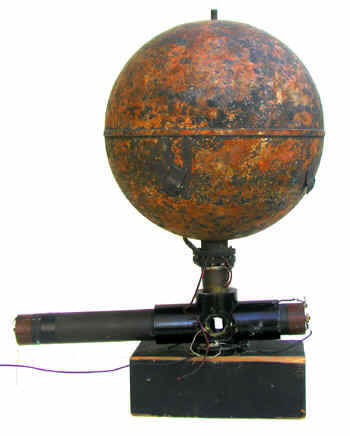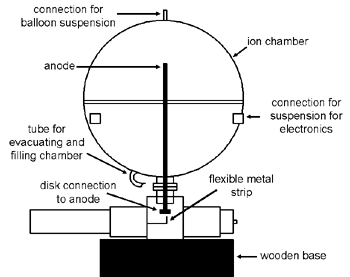Ionization Chamber Used at Robert Millikan's Laboratory for Cosmic Ray Studies

This ion chamber came from Robert Millikan’s laboratory at the California Institute of Technology. Who used it and when it was used is unclear. Dr. Eugene “Bud” Cowan, who arranged the transfer to the ORAU collection, wrote that Victor Neher identified it as having been used by Millikan in the late 1920s—a note to that effect is written on the bottom of the wooden base. Nevertheless, when I sent Neher a photograph of this chamber, he did not recognize it. Despite this, the phrase “Victor Neher, 1950s” is written in pencil on the side of the chamber.
What is certain is that the chamber is typical of those used at Millikan’s lab in the investigation of cosmic rays. In general, these chambers were attached to balloons that carried them to high altitudes (typically 70,000 to 80,000 ft.).
This particular chamber is a 10-inch diameter copper sphere with a thin (1/8”) steel rod serving as the anode. When we opened it up for inspection, we found that the chamber contained a few grams of silica gel wrapped up in a fine copper screen. The three-inch tube sticking out from the underside of the chamber was used to evacuate and fill it with argon gas. The short projection at the top of the sphere was there to hold the screw to which the line to the balloon was attached. The system electronics were suspended by cords attached to four connections located just below the chamber’s equator.

The electrical components attached to the wooden base below the chamber are a bit of a mystery. Nothing similar to them, as far as I have determined, is known to have been used at Cal Tech. As seen in the accompanying diagram, a metal extension of the chamber’s anode projects downward and ends in a small disk (ca. 0.3” in diameter). A flexible metal strip is located just below this disk. The pointed free end of the strip is bent upwards at right angles so that the tip points towards the circular disk.
The following explanation is my best guess as to how it was intended to work—I doubt that it actually worked. It is possible that the normal resting position of the flexible strip put its pointed metal tip in contact with the circular metal disk connected to the chamber's anode. During use, a constant charge was maintained on the strip. When the charge was first applied, the anode was also charged and the similar charges on the anode and metal strip would cause the latter to be deflected downward. This would break the connection between the strip and anode and leave the latter electrically isolated. As the chamber was exposed to cosmic rays, the ionization of the gas inside the chamber would reduce the charge on the anode thus reducing the repulsion between the anode and the strip. The metal strip would therefore gradually return to its resting position eventually touching the disk. This would recharge the anode and the whole process would be repeated. The frequency of this recharging of the anode was used as the measure of the intensity of the cosmic radiation. A movie camera would be used to record the movement of the strip.
The chambers normally used by Millikan and his coworkers operated in the essentially the same way. The major difference was that they employed a fine gold-plated quartz fiber that contacted the base of the anode instead of a crude metal strip that contacted a disk at the bottom of an extension of the anode.
The use of cameras to record the movement of the fiber meant that the balloon had to be recovered after it came to earth, something that was not always possible. To solve this problem, Victor Neher designed a system in the early 1950s that used radio transmissions of the signals generated by the charging cycle.
References
- Neher, H.V., An Automatic Ionization Chamber, Rev. Sci. Instr. 24 (2): 99-102; 1953.
- Neher, Peterson, and Stern, Cosmic Rays at High Altitudes and Latitudes, Phys. Rev. 90 (4): 1953.
- Neher, H.V. and Johnston , A.R. Modification to the Automatic Ionization Chamber, Rev. Sci. Instr. 27 (3): 173-174; 1956.
